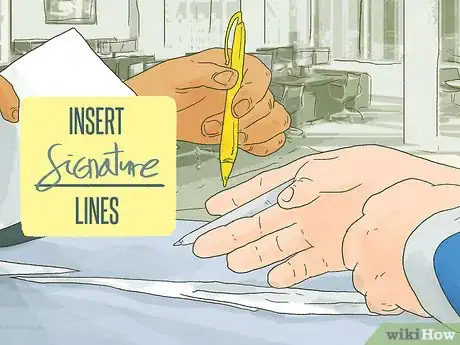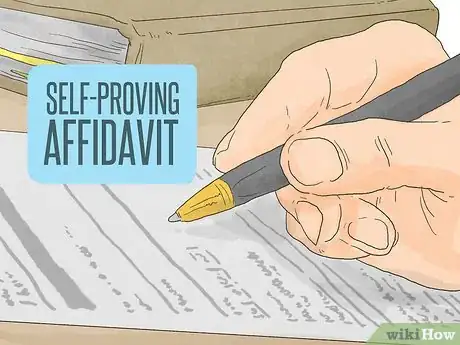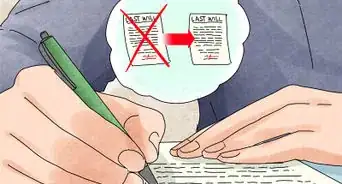This article was co-authored by Clinton M. Sandvick, JD, PhD. Clinton M. Sandvick worked as a civil litigator in California for over 7 years. He received his JD from the University of Wisconsin-Madison in 1998 and his PhD in American History from the University of Oregon in 2013.
There are 10 references cited in this article, which can be found at the bottom of the page.
This article has been viewed 15,992 times.
A will allows you to leave your property to specific individuals when you die. However, your life might change drastically after you create your will. For example, you might sell or buy properties, divorce and remarry, or have more children. In order to update your will properly, you should draft and execute an addendum or an entirely new will.
Steps
Identifying Your Reasons for Updating
-
1Read your current will. You should always have your current will handy. Take out your copy and read it. If you don’t have your copy, then ask your lawyer for a copy.
- Go through and see which property is listed and who you have designated as the “beneficiary” (the person who will receive it).
- Decide if you want to change anything. You should make all of your changes all at once. If, for any reason, you want to change the beneficiaries, you can do so.
-
2Check if you have sold property. You might have sold property since you drafted your will. Generally, this is not a problem. If you no longer own something when you die, then there is nothing to give to the beneficiary.
- However, you still might want to update your will if you have sold property. For example, you might be trying to divide your estate equally between your children. If you sold large pieces of property, then you might need to change the beneficiaries so that the property is more evenly divided between your children.
- Also, you might intend to leave your primary residence to your eldest child. However, if you move, then the property listed in your will as your primary residence is no longer yours. You need to update your will to include the new address of your primary residence.
Advertisement -
3Identify new property. If you have acquired new pieces of property, you might want to include them in your will. You will have to decide who you want to leave the property to. New property includes tangible property bought (like homes, cars, jewelry or art) or money that you have inherited.
- You don’t always have to revise the will because you gained new property. Your will should have something called a “residuary clause.” This clause covers everything in your estate which you don’t specifically leave to a beneficiary.[1]
- For example, you might have a house, two cars, some cash, and jewelry at your time of death. Your will might leave the house and cars to specific people. The cash and jewelry will then become part of your “residuary estate” and will be distributed to whoever you name as the beneficiary of your residuary estate.
- Accordingly, if you buy property after you draft your will, that property will go to the beneficiary of your residuary estate. You only need to update the will if you do not want the beneficiary of your residuary estate to get the new property.
-
4Identify new beneficiaries. You might want to update your will because you want to add someone as a beneficiary. For example, you might have married or had children since you drafted your will.
- You might have married someone. When you drafted your original will, you might have been single. Generally, your state law will allow your spouse to take a portion of your estate when you die. Depending on the state, your spouse could get 50% even if the will is silent about what your spouse should receive.[2] However, this is not always the case. In order to provide for your spouse, you should update your will.
- You also might have had children after you signed your current will. In some situations, your state might give the new child a share of your estate if he or she was born after you drafted your will. However, for extra protection, you will probably want to revise the will.
- If a child dies, then you will probably need to update the will to name new beneficiaries.[3]
-
5Revoke a will after a divorce. You might think that your will is automatically revoked when you divorce. This is not always true. In some states, your ex-spouse could still inherit property from you even after a divorce unless you update your will.[4]
- You should change your will as soon as possible after you divorce. Don’t wait until you remarry, because you could die in the interim.
-
6Change the executor. The executor (also called a “personal representative”) is the person charged with gathering all of your estate property, paying off your debts, and then distributing the remainder to the beneficiaries. You should update your will if you want to change the executor.[5]
- Your executor may have died or become incompetent. Also, the current executor might have told you that he or she doesn’t want to serve in that capacity anymore.
- Before naming a new executor, you should ask the person if he or she wants to serve. An executor named in the will always has the option of declining to serve in the role, so you want to make sure that whoever you name is willing to serve.
-
7Name new guardians. In your will, you probably also named the guardians for your children. If you want to change the guardian, then you should update your will.
- As with the executor, make sure that the person you appoint as guardian wants to serve in that role.
-
8Meet with a lawyer. You should probably meet with a lawyer to discuss the best way to update your will.[6] After meeting with the lawyer, you might find that you don’t have to update the will at all.
- If you used a lawyer to help you draft your current will, you should reconnect with the attorney. Call and say that you want to discuss updating your will. You can schedule an appointment.
- You might not have used a lawyer to help draft your original will. In this case, you will need to find a will attorney by getting referrals. You can ask people that you know if they would recommend their lawyer.
- You can also get a referral by contacting your state or local bar association, which should run a referral program.
Updating the Will with a Codicil
-
1Use a codicil for small changes. If you want to make a few minor changes to the will, then you should use a “codicil.” A “codicil” is an addendum to the will. It can add to the existing will or make deletions in the existing will.
- A codicil is a legal document, just like the will. Accordingly, you need to draft and execute the codicil in the same way that you did the will.[7]
- For example, you will probably need witnesses to testify to your signature and also have the codicil notarized.
-
2Avoid making handwritten changes. You might think you can revise your will by making handwritten changes on the document by crossing out someone’s name or inserting a gift. You should not do this.[8]
- If you write on your will, then a judge might decide the entire will is invalid.[9] You also won’t be around to tell the judge who you want to leave your property to. Accordingly, you will lose control of who gets your property.
-
3Title the codicil. At the top of the page, you should title the document “Codicil to the Last Will and Testament of [insert your full name].”[10]
-
4Draft the opening paragraph. The purpose of the opening paragraph is to identify yourself and state that you are executing a codicil. You also need to identify the will you are amending.
- Sample language could read: “I, Beth Smith, residing and domiciled in the City of Bangor, County of Penobscot, and State of Maine, hereby make, publish, and declare this to be a Codicil to My Last Will and Testament dated [enter the date of the will, not the date of the codicil].”[11]
-
5Identify the additions or deletions. You need to explain what provisions in the will you are adding or deleting. Identify the article and paragraphs.
- For example, you can write: “I delete from my Will Article IV, Paragraphs 1 and 2 in their entirety.”[12]
- To add something, you can write, “In Article IV, Paragraph 1, I insert the following….”
-
6Republish the will. After you enter the additions or revisions, you should republish the will. You can do that by adding the following language:
- “Except as herein amended, my Will shall remain in full force and effect, and, so I hereby remake, re-declare, and republish my Will, together with these amendments, as my Last Will and Testament.”
-
7Insert signature lines. You will need a line for your signature and the date. Depending on your state law, you will also need to add lines for witnesses. Most states require at least two witnesses.
- Look on your will to see how many people witnessed your signing of the will. Unless your state has suddenly changed the law, you will need the same number of people to witness your codicil. Insert a signature line for each witness.
Drafting an Entirely New Will
-
1Draft a new will for large changes. You can also update your will by creating an entire new will. You should choose to draft a new will (instead of adding a codicil) when you have large changes to make or are making several smaller ones. You should certainly draft a new will if any of the following is true:[13]
- You have a change in marital status—you either divorce or get married.
- You want to leave a sizeable part of your estate to a new beneficiary.
- Your assets have increased or decreased significantly.
-
2Use the same software program. You might have drafted your original will with the help of computer software. You can use the same software to draft the new will.
- If you didn’t use software, then you will have to update the will by typing up a new version or editing the electronic version stored on your computer.
- If you had a lawyer draft the original will, then you can ask the lawyer to draft an entirely new will. Give your lawyer the changes you want to make.
-
3State that you are revoking your prior will. In the first paragraph of your new will, you should state that you are revoking any prior wills. By including this sentence, you make clear that you know that you have a prior will and that you are consciously revoking it.
- Sample language could read: “I hereby revoke any and all old Wills that I have previously made.”[14]
-
4Draft the will. If you are typing up your own will, then you hopefully saved the prior will in a word processing document. You can then simply enter any revisions that you want to make.
- If you have to type it up all over again, then be especially careful that you include all information in the new will that you put in the original. For example, you don’t want to forget to put in the names of your children’s guardians in the new will. Because you are revoking your older will, then the guardians listed in that old will no longer be the guardians.
-
5Show the will to a lawyer. Out of extra caution, you should show your new will to a lawyer. Also give the lawyer the old will you want to revoke. The lawyer can then review the two to make sure you haven’t forgotten anything.
Executing the Codicil or New Will
-
1Read your state law. Your state law will explain what you need to do to make the codicil or will official. You can find your state’s requirements by searching the Internet for “your state” and “wills.”
- Your state law should tell you whether you need witness and how many.
- It may also tell you how to authenticate the codicil or new will. By including a self-proving affidavit, you can speed up the will’s admission into probate. Without the affidavit, your executor would typically have to track down one of the witnesses to identify the signature on the will as yours. With a “self-proving” affidavit, a judge will presume your will was correctly executed and will admit the will unless someone challenges it.
-
2Get witnesses. Your state might require that two or more witnesses observe the execution and sign as well. Make sure that the witnesses are not people who are beneficiaries under the will.
- For example, if you are leaving property to your children, then you should not have the children serve as witnesses.
- Above the signature lines for the witnesses, you should include the following language:
- “The foregoing instrument was signed, sealed, declared, and published by [insert your name] as and for a Codicil to his Last Will and Testament dated [insert date], in the presence of each of us, and we at the same time, at his request, in his presence and in the presence of each other, have hereunto subscribed our names as attesting witnesses.”
-
3Sign in front of a notary. You will also need to have the codicil or will notarized. You can find a notary by visiting the courthouse or a large bank. You can also find a notary by using the Locator function at the website for the American Society of Notaries.[15]
- You should search the Internet for an appropriate notary block for your state. Insert the notary block at the bottom of the codicil or will, beneath the lines for the witness signatures.
- Be sure to have personal identification to show the notary. A valid driver’s license or passport is usually sufficient.
-
4Complete a self-proving affidavit. You should probably include a self-proving affidavit. Look at your state law, which should provide sample language to include in the affidavit. You and your witnesses should sign the affidavit when you appear in front of the notary to sign the codicil or new will.
- Each state has slightly different requirements for the self-proving affidavit. For example, New York’s self-proving affidavit does not satisfy Georgia’s requirements. Accordingly, you should draft the affidavit to satisfy your state’s laws.
- To find sample language for your state, type “your state” and “will affidavit” or “self-proving affidavit will.” Look for websites that end in “.gov.” These are official state websites.
-
5Distribute copies. If you drafted a codicil, then make sure that you give the original to whoever is holding the original copy of your will. Your lawyer might have the original, or you might be storing it in a safety deposit box. Attach the codicil to the will.
- Also distribute copies of the codicil to whoever has copies of the will.
- If you revoked an old will by drafting a new one, then give copies of the new will to whoever has copies of the old version. Send a letter telling them that you have revoked your old will.
- Keep a copy of the codicil or will for your own records.
-
6Destroy old wills. To avoid confusion, you might want to destroy all copies of your older will.[16] If your lawyer has the original copy of your old will, then can ask that the lawyer destroy it.
References
- ↑ http://estate.findlaw.com/wills/sample-basic-will-annotated.html
- ↑ https://www.freeadvice.com/legal/when-and-how-should-i-revise-my-will/
- ↑ https://www.freeadvice.com/legal/when-and-how-should-i-revise-my-will/
- ↑ https://www.freeadvice.com/legal/when-and-how-should-i-revise-my-will/
- ↑ https://www.freeadvice.com/legal/when-and-how-should-i-revise-my-will/
- ↑ http://blogs.findlaw.com/law_and_life/2013/06/legal-how-to-revising-your-will.html
- ↑ http://blogs.findlaw.com/law_and_life/2013/06/legal-how-to-revising-your-will.html
- ↑ http://blogs.findlaw.com/law_and_life/2013/06/legal-how-to-revising-your-will.html
- ↑ https://www.freeadvice.com/legal/when-and-how-should-i-revise-my-will/
- ↑ https://www.unitedwaydanecounty.org/documents/Codicil_Residuary.pdf
- ↑ https://www.unitedwaydanecounty.org/documents/Codicil_Residuary.pdf
- ↑ https://www.rocketlawyer.com/document/codicil-to-will.rl
- ↑ https://www.freeadvice.com/legal/when-and-how-should-i-revise-my-will/
- ↑ http://estate.findlaw.com/wills/how-to-revoke-a-will.html
- ↑ https://www.asnnotary.org/?form=locator
- ↑ http://blogs.findlaw.com/law_and_life/2013/06/legal-how-to-revising-your-will.html





















































































